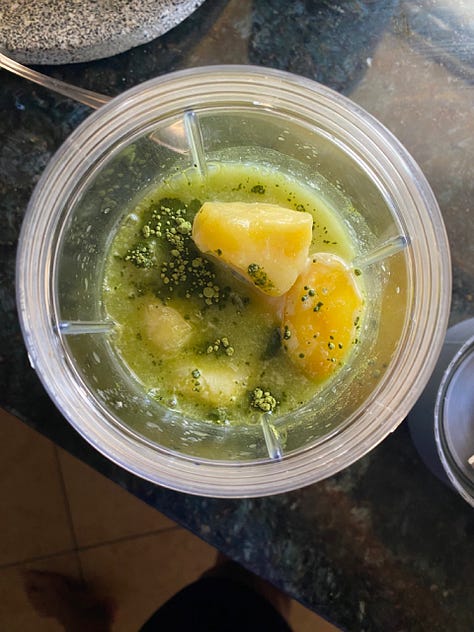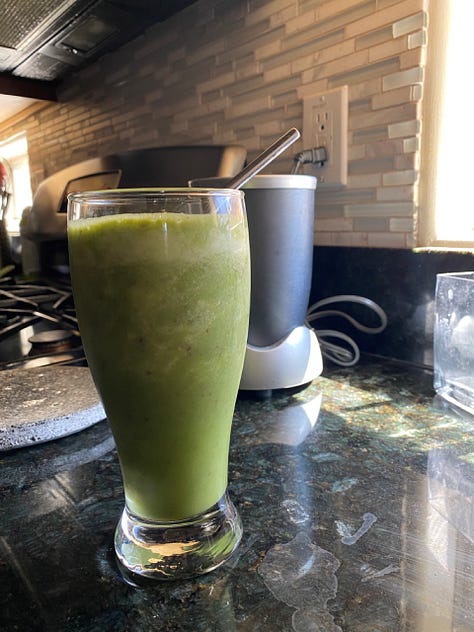Matcha: The Superfood You Should Stop Ignoring
An Easy & Breezy approach to this superior ingredient
Contains recipes at the end ;)

Matcha! It’s kinda like cilantro: those who like it, love it, and those who don’t, hate it.
If you’re in the second group, keep reading because you might find reasons to give it another chance.
I love matcha, from the grassy and umami taste to the vibrant green!
I’m sipping on a matcha latte as I type. Now that the weather is getting cooler, a warm “hug in a mug” is a nice touch for the evening.
That’s another thing I love about matcha, the versatility. You can have it warm or cold, even bake and cook with it (I still need to try it in savory dishes).
Most times I consume matcha in a smoothie or juice. For weeks I’ve had it every day, mixing it with spinach and pineapple as a base and adding whatever called to me that day, like oranges, passion fruit, and mangos.
I’ll share a few recipes at the end.
For now, let’s take a look at matcha’s loaded health benefits.
Not your average Green Tea
Both matcha and green tea come from the Camellia sinensis plant, but matcha is made by grinding green tea leaves into a powder, while green tea is made by steeping loose tea leaves in hot water.
They are also cultivated differently. Green tea is cultivated under the sun, while matcha is shade-grown in the three weeks before it is harvested. The shade increases the chlorophyll levels in the leaves, giving matcha its bright color, and triggers a stress response that supercharges it with antioxidants called polyphenols—up to 300 times more than regular green tea.
Huge difference!
When you sip matcha, you’re drinking all that goodness, plus gut-friendly fiber that comes along for the ride. Remember, you are ingesting the leaf.
Key Nutrients that make Matcha a Superfood
Catechins (EGCG): are powerful antioxidants found in matcha that help protect your cells from damage, reduce inflammation, and support heart health. They also give your metabolism a little nudge, making them great for weight management.
Polyphenols: help fight inflammation, improve circulation, and lower the risk of chronic diseases like diabetes."
Chlorophyll: it’s like a detox superhero for your body. Chlorophyll helps cleanse your liver, remove toxins, and promote healthy skin.
L-Theanine: this unique amino acid works wonders for your brain. It enhances focus and calmness, helping you stay sharp and relaxed at the same time.
Caffeine: Paired with L-Theanine, it creates a smooth, sustained energy without the jitters.
And if that wasn’t enough, studies suggest matcha extracts can even target breast cancer stem cells, making it a true powerhouse ingredient.
Is Matcha a better source of caffeine than Coffee?
In matcha, caffeine is a gentle stimulator that wakes you up and keeps you alert.
Matcha's caffeine is released more slowly than coffee's, again thanks to the amino acid L-theanine. This can help you feel alert for longer, without the crashes that can come with coffee.
Half a teaspoon of matcha contains about 30mg of caffeine, while black coffee averages 100mg.
The good news? You don’t have to choose between them!
In the book I’m reading Eat to Beat Your Diet, by William W. Li, MD, he suggests 3 must-have drinks for overall good health:
Water + Teas + Coffee!
Matcha tea is one of the three teas he recommends, along with Oolong and Pu’er tea.
Of course, don’t overdo it with caffeine. Moderation is the best way to consume pretty much everything, good or bad for you.
Dr. Li dives deeper into these three drinks in this video, if you’d like to learn more.
Ready for some Recipes?



Matcha Latte
1 1/2 cups of almond milk
1 Tablespoon of matcha (I use Organic Everyday Matcha from Sencha Naturals)
1/2 Tablespoon of Laird Superfood Creamer
Agave (or the sweetener of your choice) to taste
How to:
Pour the milk into a roomy measuring cup (you’ll need room to whisk) and take it to the microwave for 1 minute.
Add matcha and Laird to the milk, and whisk it with a fork. For a better result use a drink mixer/milk frother like this.
Microwave it for one more minute.
Now add the sweetener, mix again, and microwave for 30 more seconds if you want it hotter.
It’s ready to pour into your best mug and enjoy!
*Note: This recipe makes a bold matcha latte and contains approximately 180mg of caffeine. If you want a milder flavor, use a little less matcha.
Matcha Protein Shake
1 cup of almond milk
2 Teaspoons of matcha
1/2 scoop (of their measure cup) of Vanilla Jocko Mölk Whey Protein Powder
1/2 cup of frozen mango (for thickness)
Mix all in the blender (you already know I use NutriBullet) and it’s done.
Very creamy and very yummy!
Great in the morning for longer periods of alertness and feeling satisfied. It contains approximately 120mg of caffeine.
Everyday Pineapple Matcha Power Juice
1 cup of spinach
1/2 Tablespoon of matcha
1 cup of almond milk
1/2 cup of water
1 cup of frozen pineapple
1 teaspoon of Laird (optional for coconut flavor)
1 teaspoon of agave or the sweetener of your choice
Feel free to add to taste:
Frozen mango
Passion fruit puree
Mix it all in that magical blender and you’ll have a delicious refreshing drink, packed with good-for-you stuff!
That’s all for today! But before we go, please let me know:
Until next time,
If you enjoyed today’s post, hit the heart below and share it with others. 🧡
Easy & Breezy is a publication centered on curiosity about food and an all-around healthier lifestyle in a relaxed and practical way. I am sharing from my kitchen, my experiences, and my heart, as an exploration of self-expression and connection.





